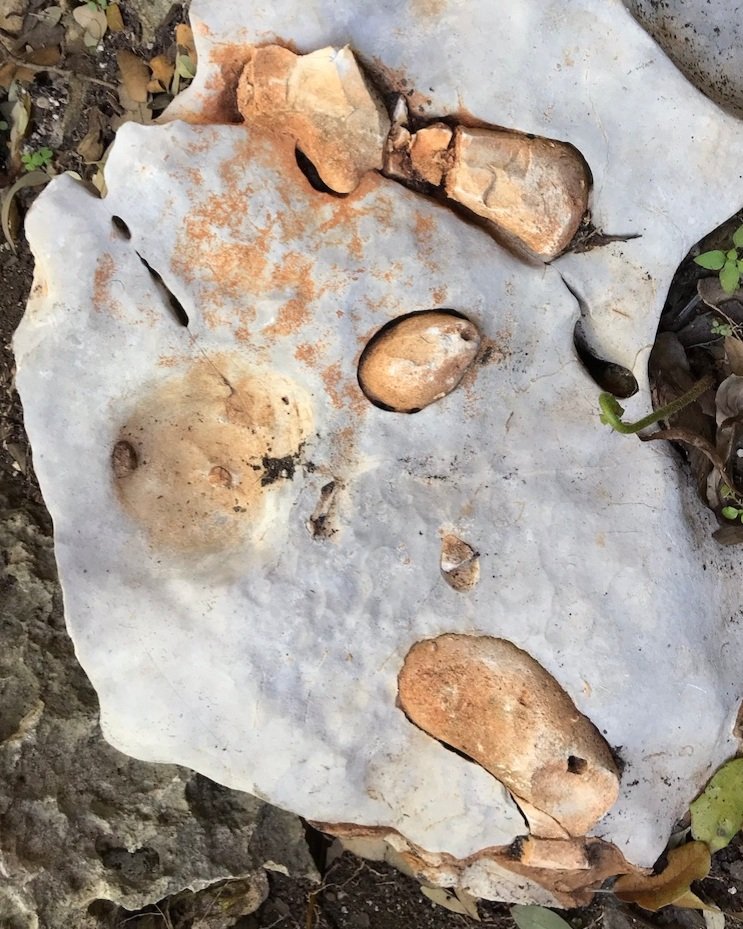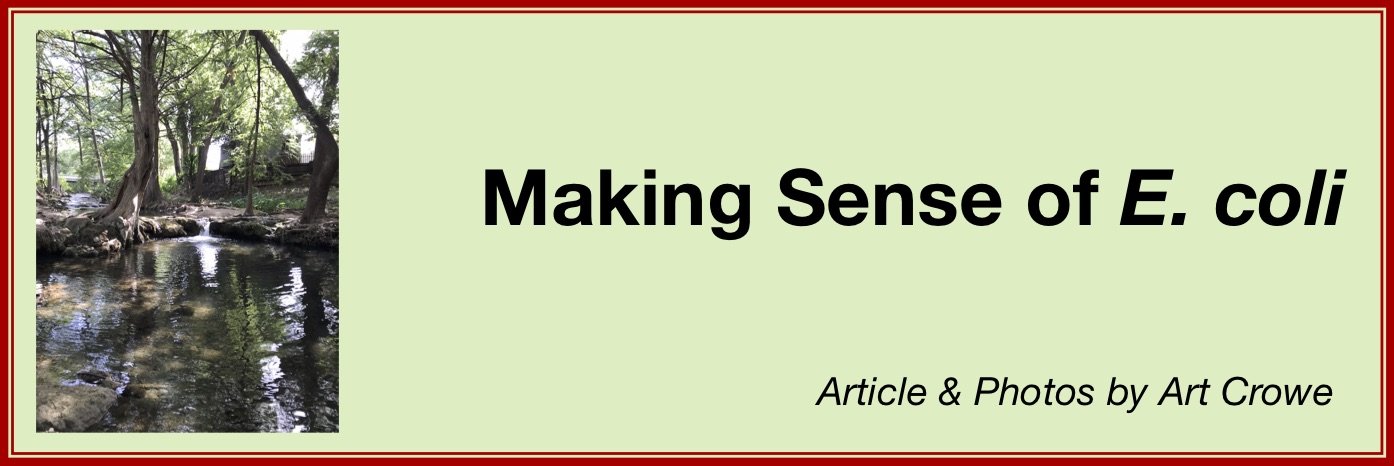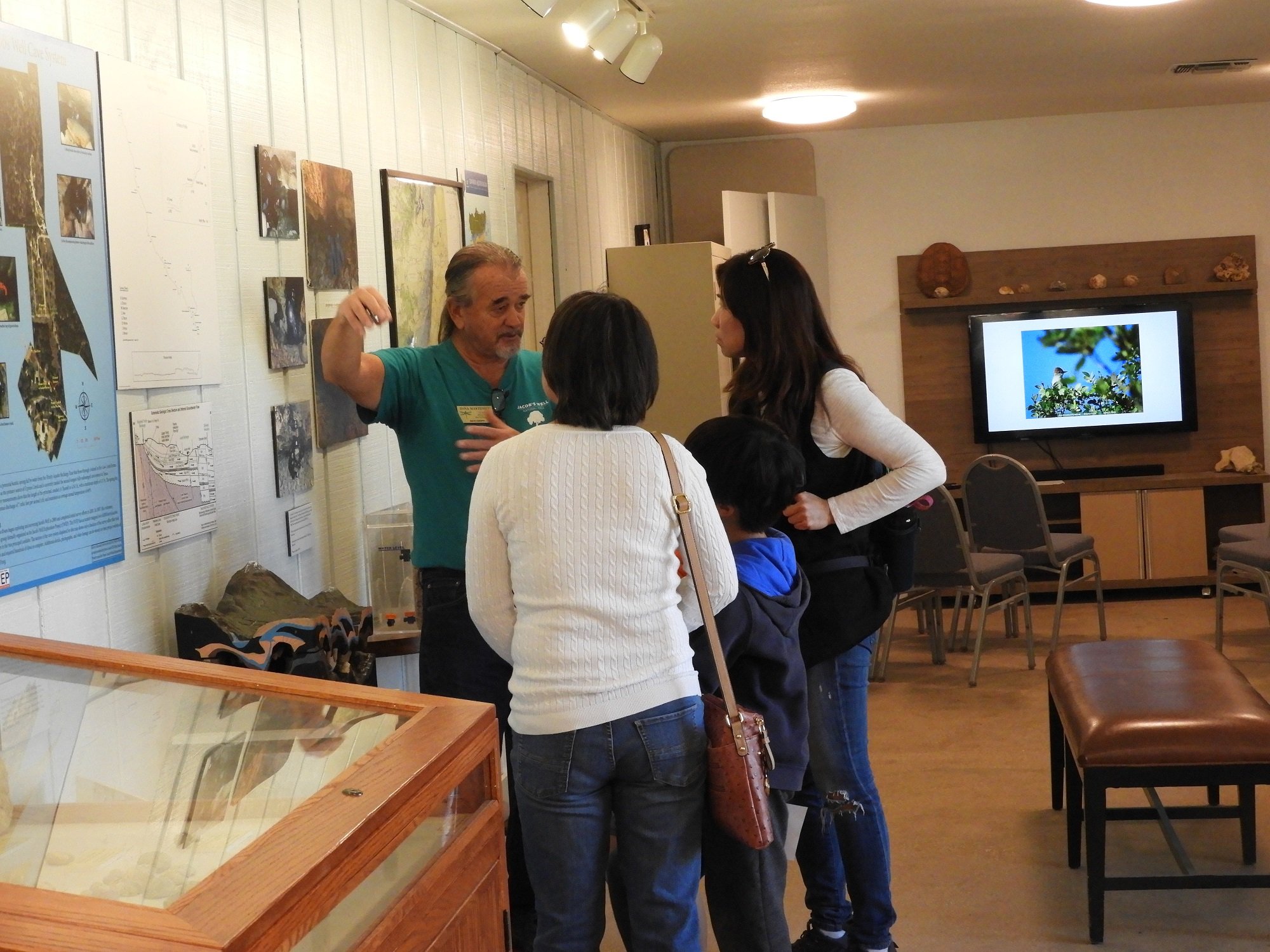The Hays Humm - February 2019
TOM JONES & BETSY CROSS
Patty Duhon - Grand Canyon shower.
PATTY DUHON
About Myself: I was reared by a tiny little woman with a huge sense of adventure. Mom was a WWII Army nurse that got her pilot's license after the war was over and never turned her back on learning anything new. She had a love of plants and rocks that I inherited, and I like to think that she is sitting beside me every time I propagate another plant, harvest and scatter grass seeds, or turn over and pick up a new rock. I have been digging in the dirt all my life and I still get a big grin on my face when something I'm nurturing shows signs of new growth.
You may not know: I've been recycling since the early 70's--yes, because my mother jumped into the environmental movement with both feet when I was still living at home. My son loves to tease me about my Hippie ways (including getting tear gassed during an anti-war demonstration in my college days), and I accept his teasing proudly.
FAV MN Activities: As a 2018 graduate of the HCMN training class (Go Foxes!!!), I enjoyed weeding the flower beds at the San Marcos Discovery Center and cleaning the tanks at the San Marcos Aquatic Center. I spent my career years as a Professional Therapist and School Counselor and I dealt with highly emotionally charged issues on a regular basis. I think the weeding and tank cleaning are wonderfully mindless activities that allow my brain to travel to any topic and dwell in solitude while tidying up where needed.
I will have to admit, however, that working with Tom Jones on the newsletter article about flint has been the most FUN single activity I've done in a very long time. I had forgotten how I love rocks!!! I mean...I look for them constantly and pick them up all the time, but these days it's more to clear a field or pathway. Tom and I LOOKED for flint (It was easy; it was everywhere.). We searched for a purpose and for several weeks I was reminded of my youth and of my Mom.
What Bird am I? Deciding which bird I most identify with is an interesting challenge. We watch them from the porches. We try to identify them by their songs. I keep going back to my chickens, though, and how much pleasure I used to get from watching them. I think I identify with them because they are industrious! They are always searching for food, scratching here and there, turning over sticks and rocks, busy, busy, busy! I had one jump up and try to snatch a piece of BBQ off my plate! --determined! I admire those qualities in humans AND in chickens.
PAULA GLOVER
About Myself: I am a fifth generation Texan, who was born and raised in San Antonio. I ventured out to Sul Ross State University in Alpine for my undergraduate degree, and discovered I loved the outdoors and have avoided large cities ever since. I have been married to Fred for 32 years and we have one son, David, who is in Kansas City. While we did spend 8 years in South Dakota and 7 years in Oklahoma, we came back to Texas ASAP. We moved to our retirement home in Comal County in 2013, and I joined the MN Class of 2016 (Ravens) as a New Year’s resolution to learn how to best “zero-scape” around our home.
You May Not Know: I am a LMSW – Licensed Master Social Worker - (retired), and worked in a variety of social work roles, including Adult Protective Services, school social work, teaching a college class, and Hospice/Home Health.
FAV Master Naturalist Activity: Most of the time, it’s the most recent thing I did. While I have ventured into a number of volunteer opportunities, I continue to return to the Training Committee, this being my third year. It is my job to help feed the new class, but they actually nourish me with their enthusiasm and varied experiences. This is also one of the best ways to get to know quite a few folks.
Bird I Most Identify With: The roadrunner because they are tough ol’ birds. Nesting in cactus and eating rattlesnakes – not every bird can do that!
“I will not live long enough to fully appreciate what is on my property”
Patty Duhon
My husband and I moved to San Marcos 10 years ago and purchased property in the hills west of town. I started exploring our property and immediately noticed the rocks that littered the ground. There was such variety of shapes, colors and forms.
Growing up in Orange, Texas I was a rock enthusiast but did’t make many discoveries. I still have a couple of rocks from the fourth grade. I painted them with clear fingernail polish to bring out the vivid colors. I got my love of rocks from my Mom. On every trip, she collected a rock and would write the location and date found on the back. When she died, there was a BIG conversation about who would inherit her rocks. ; )
I am outside often working the garden and doing chores. While walking, my head is down scanning the ground for anything that catches my eye. After a heavy rain is always a good time to take a walk and hope to find something special. My efforts are often rewarded. I collect many beautiful pieces of flint and other mineral specimens, moving them to a pile, rock wall or adding to a landscaping project. Over the years, the many rocks I collected resulted in displays throughout the yard and filled many bins with my favorite collections.
Snail Geode
Fossil snail embedded into limestone matrix. Note the quartz crystal filling inside the snail creating a geode-like interior.
My early goal with the rock landscaping displays was to have something in the yard to share with my grandkids when they visit. I wanted them to join me on a walk looking for flint. I was a little saddened but not surprised when they were not interested. My favorite flint color is black with a white limestone coating the outside. Another favorite is blue with specks of white over the surface. These are hard to find, and it is always a treat to locate one.
Recently my husband and I started clearing a cedar grove which exposed a new area that had not been searched previously. There was so much beautiful flint, with several pieces showing signs of being shaped into tools. I sent a photo to Tom and invited him to come to San Marcos to walk the property with me and hopefully explain how these deposits were formed.
Tom Jones
I first met Patty in September 2018 as I was preparing to lead a geology walk on her property for a training class site visit. She showed me her extensive rock collection and asked me about how they were made and what created the unusual shapes. Patty and I share a love of rocks. In December, she invited me to explore an area that was just exposed after clearing the cedar trees. After I accepted, Patty agreed to collaborate on an article for the newsletter. I could help her understand the formation of flint, its importance in San Marcos and also share this information with the Chapter.
Flint, a variety of chert, is a sedimentary rock that can be found in many areas of Hays County. It is a hard and durable mineral formed from the silica (quartz) rich skeletal remains of marine organisms. Flint refers to the type of chert deposited in limestone. It is formed into nodules or in layers, which are referred to as ledge flint. It is common to see a thin layer of limestone covering the outside of the nodules, typically white and rough in texture. Flint varies greatly in color from white to black, but most often manifests as shades of gray, brown, grayish brown, light green and blue.
About 100 million years ago, large populations of very small organisms such a diatoms and radiolarians lived in the shallow sea creating tiny structures made of biogenic glass or silica. Their silica remains accumulated in thick deposits on the sea floor, forming siliceous oozes. This process is relatively rare and only makes up about 15% of the sea floor. Both the limestone and flint were formed concurrently. That is why flint is found embedded in a limestone matrix. The floor of the shallow sea had marine worm holes and other burrows, creating narrow tubes and cavities in the sediment. The silica rich ooze filled these openings and hardened into the flint nodules we see today.
The abundant natural resources in eastern Hays County sustained populations for thousands of years at what is now known as Spring Lake. A key resource was flint. Flint was used to fabricate a wide variety of stone projectiles, points, scrapers, knives and other tools. It is not known if the flint on Patty’s property was quarried by these indigenous peoples. I think it is likely because its location is only a short hike from the springs. Another notable location is the famous Georgetown flint in Williamson County. Georgetown flint is the name given to an unusually good chert variety that occurs along the eastern fringe of the Edwards Plateau. Numerous artifacts include large and especially thin bifaces which were made from this material. It is noted that flint deposits in Hays County are regarded as a ‘close cousin’ to Georgetown flint. Information on Georgetown flint was extracted from an interesting article at this LINK.
Having the opportunity to visit Patty and explore her property was an incredible experience. Next time you are walking on your property after a good rain, keep your head down and you may be surprised at what you find.
Samples of flint Patty donated to the Jacob’s Well Nature Center.
Patty’s Addendum: Recently, my six year-old grandson spent time with me walking around the cleared areas over the holidays and got excited about finding and picking up pieces of flint! He even selected some “favorites” that he took home with him to Dallas. My Colorado grandson will be here in March. I’m hoping the weather allows us to go exploring for artifacts. I’m looking forward to spending time with like-minded grandchildren!
Master Naturalist Photo Contributions
I spent the last 15 years of my career collecting water quality samples for the Texas Commission for Environmental Quality in the 22 county area of Northeast Texas. The two biggest water quality issues in that part of the State were bacteria and low dissolved oxygen (DO). In contrast, we hardly ever have low DO in the Hill Country because we have flowing streams compared to sluggish bayous.
How to interpret results
Escherichia coli is found in the digestive system of all warm blooded animals. (It is not found in your urinary tract. If it is there, you are in trouble.) E.coli is used as an indicator organism in water quality sampling. There are only a few strains that are pathogenic. (Think of the recent romaine lettuce recalls because of E.coli 0157:H7.) The vast majority of strains are helpful, even necessary for digestion. So why test for it? It turns out that E.coli is a good indicator of the presence of many other pathogenic bacteria. When E.coli concentrations are high, the incidence of stomach related illness goes up in swimmers, but most likely because of pathogens other than E.coli. Water Quality Standards are compared to individual samples as well as for long-term averages. A single sample should not exceed 394 colonies/100 milliliters. But the more important regulatory sample result is the geometric mean (different from a simple average) of at least 10 samples collected over a relatively long period of time, at least one year.
All warm blooded animals have E.coli in their guts.
When samples should be collected
It becomes very important when to collect samples for this geometric mean. It is very easy to bias the results. A random sample design is needed. If you target samples to one or two days after a rain, you will get more exceedances than if you were to randomly select the sample days. Everywhere in the state, bacteria concentrations spike after any rainfall event that causes runoff. Bacteria attach themselves to sediment particles. As long as the sediment is suspended in the water column, they are subject to being ingested by an individual. With time, these sediment particles settle and are no longer a concern. There is a group of individuals that collect bacteria samples in Wimberley on the first Monday after Market Days. This is random sample design and that is good.
Limitations of source tracking
Source tracking has its limits. It is expensive, and it is only as good as the regional “library” of data with which to compare. It can only tell you presence or absence, not relative importance. To my way of thinking, livestock and wild animal sources should be expected after a rainfall in just about every rural waterbody in Texas. Not so with human sources. They do not belong in the creek anytime. Properly run septic systems as well as city owned sewer systems should not contribute to the bacterial waste load of any waterbody.
Some common sense suggestions
Numerical standards are OK, but they give you yesterday’s data. The water you are swimming in today is miles downstream by the time the samples are read the next day. So it’s an educated guess as to the real water quality today. Young children are more likely to accidentally ingest water while out on the river than are adults and therefore are at greater risk than adults. There are no guarantees in life, but keep the kids out of the river for 48-72 hours after a significant rainfall event and you should be good.














































